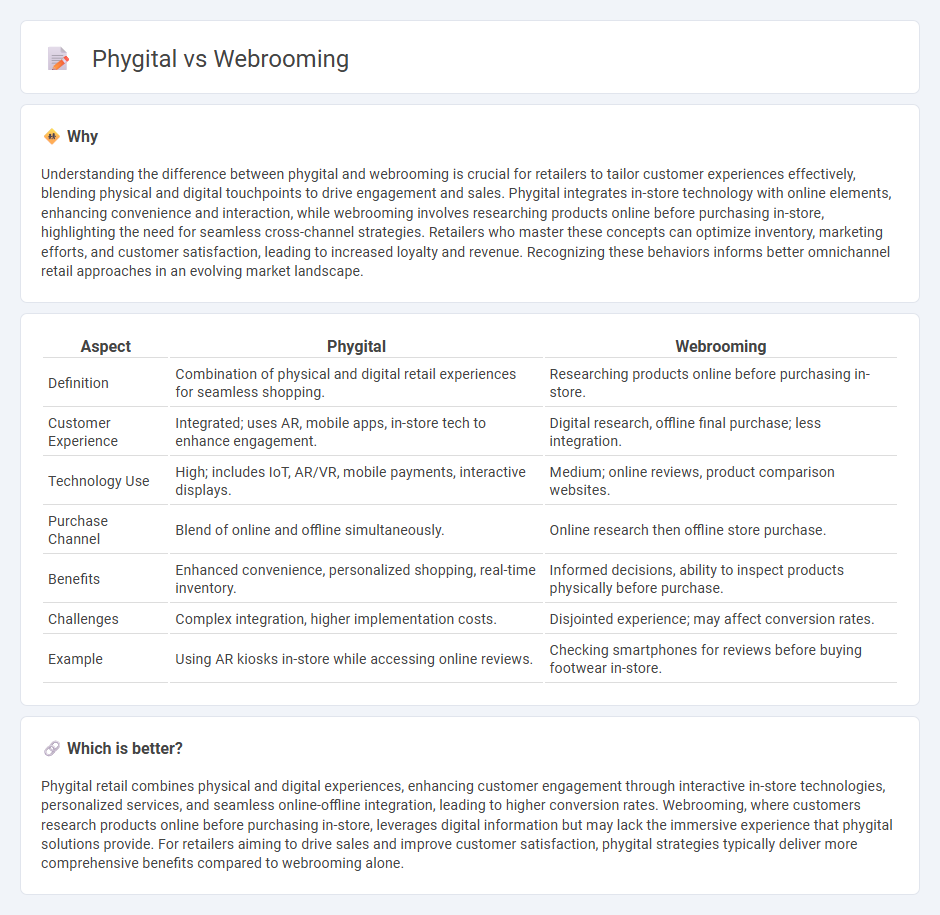
Phygital retail seamlessly combines physical store experiences with digital technology to enhance customer engagement and convenience. Webrooming, a consumer behavior where shoppers research products online before purchasing in-store, impacts sales strategies by bridging digital and physical touchpoints. Explore how these approaches transform retail dynamics and shopper experiences.
Why it is important
Understanding the difference between phygital and webrooming is crucial for retailers to tailor customer experiences effectively, blending physical and digital touchpoints to drive engagement and sales. Phygital integrates in-store technology with online elements, enhancing convenience and interaction, while webrooming involves researching products online before purchasing in-store, highlighting the need for seamless cross-channel strategies. Retailers who master these concepts can optimize inventory, marketing efforts, and customer satisfaction, leading to increased loyalty and revenue. Recognizing these behaviors informs better omnichannel retail approaches in an evolving market landscape.
Comparison Table
| Aspect | Phygital | Webrooming |
|---|---|---|
| Definition | Combination of physical and digital retail experiences for seamless shopping. | Researching products online before purchasing in-store. |
| Customer Experience | Integrated; uses AR, mobile apps, in-store tech to enhance engagement. | Digital research, offline final purchase; less integration. |
| Technology Use | High; includes IoT, AR/VR, mobile payments, interactive displays. | Medium; online reviews, product comparison websites. |
| Purchase Channel | Blend of online and offline simultaneously. | Online research then offline store purchase. |
| Benefits | Enhanced convenience, personalized shopping, real-time inventory. | Informed decisions, ability to inspect products physically before purchase. |
| Challenges | Complex integration, higher implementation costs. | Disjointed experience; may affect conversion rates. |
| Example | Using AR kiosks in-store while accessing online reviews. | Checking smartphones for reviews before buying footwear in-store. |
Which is better?
Phygital retail combines physical and digital experiences, enhancing customer engagement through interactive in-store technologies, personalized services, and seamless online-offline integration, leading to higher conversion rates. Webrooming, where customers research products online before purchasing in-store, leverages digital information but may lack the immersive experience that phygital solutions provide. For retailers aiming to drive sales and improve customer satisfaction, phygital strategies typically deliver more comprehensive benefits compared to webrooming alone.
Connection
Phygital retail integrates physical and digital experiences, enhancing customer engagement through seamless interactions across both channels. Webrooming, where shoppers research products online before purchasing in-store, exemplifies the phygital approach by blending digital product discovery with tangible buying experiences. Retailers leveraging phygital strategies optimize webrooming behaviors, driving foot traffic and increasing conversion rates by aligning online information with in-store availability.
Key Terms
Omnichannel
Webrooming enhances the omnichannel experience by enabling consumers to research products online and complete purchases in physical stores, blending digital convenience with tactile interaction. Phygital strategies merge physical and digital touchpoints to create seamless shopping journeys, integrating mobile apps, in-store tech, and online platforms for consistent branding and personalized service. Explore the impact of omnichannel approaches on consumer engagement and sales growth in retail.
Customer Experience
Webrooming enhances customer experience by allowing shoppers to research products online and finalizing purchases in physical stores, blending digital convenience with tactile interaction. Phygital strategies integrate digital technologies within physical retail spaces, creating seamless, immersive experiences such as augmented reality try-ons and interactive kiosks that drive engagement and satisfaction. Discover more about how these approaches transform customer journeys and boost retail performance.
Channel Integration
Webrooming involves researching products online and purchasing them in physical stores, blending digital browsing with tactile, in-person buying, while phygital emphasizes a seamless integration of physical and digital channels to create a unified shopping experience. Channel integration in webrooming relies on accurate online information and efficient inventory synchronization to drive foot traffic and enhance customer satisfaction. Explore how strategic channel integration is revolutionizing consumer behavior and boosting retail performance.
Source and External Links
How webrooming benefits brick and mortar stores - Clientbook - Webrooming is when customers research products online but then purchase them in physical stores, allowing retailers to leverage online browsing to increase in-store traffic, conversion rates, and opportunities for upselling and cross-selling.
Webrooming - Salsify - Webrooming refers to consumers researching a product online, including details and reviews, before purchasing it in a brick-and-mortar location, combining the convenience of online discovery with the trust of seeing products in person.
Research online, purchase offline - Wikipedia - Also known as ROPO or reverse showrooming, webrooming describes shoppers who research product information online before buying their preferred product in a local physical store, a common behavior especially for high-value items.
 dowidth.com
dowidth.com